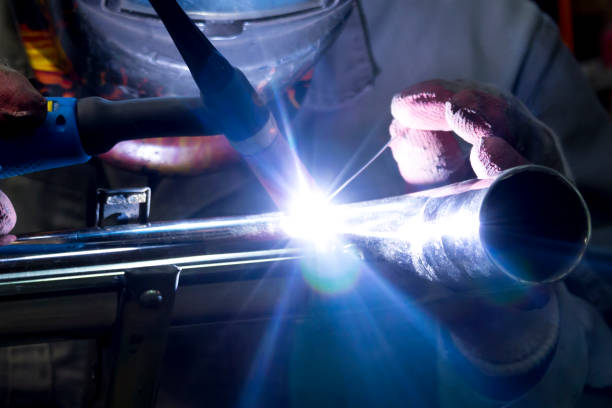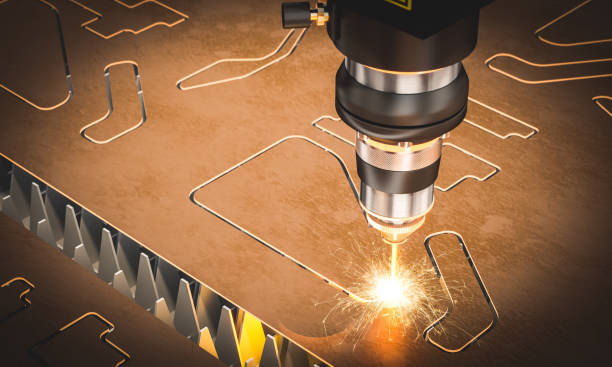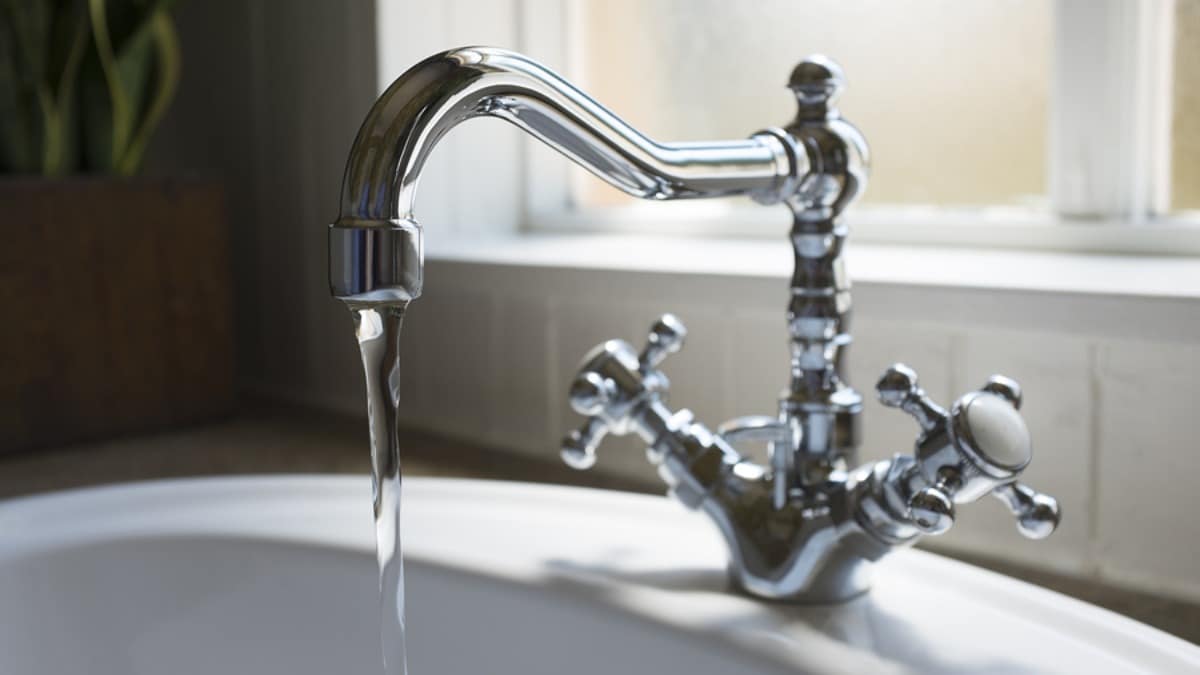How does plasma cutters work and what are they exactly? Understanding the science behind plasma cutters will enable you to understand how inert gas can be transformed into a scorching plasma capable of slicing through metal with unparalleled accuracy.
In this piece, we’ll cover everything about plasma cutters and how they work.
Table of contents
What Is A Plasma Cutter?

A plasma cutter is a high-precision tool used in metalworking that employs a stream of ionized gas, known as plasma, to cut through conductive materials such as steel, aluminum, copper, and other metals. This process involves creating an electrical arc that passes through the gas, turning it into a plasma state with temperatures reaching up to 30,000 degrees Fahrenheit. The intense heat melts the metal, while a high-velocity jet of gas blows away the molten material, resulting in precise and efficient metal cutting for various industrial applications.
What Are The Gases Used In A Plasma Cutter?

Plasma cutters utilize a combination of gases to generate the high-temperature plasma needed for cutting through metal. The primary gases involved in this process include:
Inert Gases (usually Argon or Nitrogen):
– Role: Inert gases, such as argon or nitrogen, serve as the primary working gas in plasma cutting. They do not chemically react with the metal being cut.
– Function: The inert gas is responsible for creating a stable arc between the electrode and the workpiece. It initiates the ionization process, turning the gas into plasma.
Plasma Gas (usually Oxygen or Air):
– Role: Plasma gas is introduced to the process to enhance the cutting capability by reacting with the molten metal.
– Function: When oxygen or air is used as the plasma gas, it reacts with the molten metal, accelerating the cutting process by providing an exothermic reaction. This reaction produces additional heat, making it particularly effective for cutting ferrous metals like steel.
Shielding Gas (usually Argon, Hydrogen, or Helium):
– Role: Shielding gases protect the electrode and the cutting area from oxidation and ensure a stable cutting arc.
– Function: By surrounding the plasma arc, shielding gases prevent atmospheric elements from interfering with the cutting process. They also help maintain the integrity of the electrode and enhance the overall efficiency of the plasma cutting system.
The selection of gases depends on the specific material being cut and the desired cutting characteristics. For instance, using oxygen as the plasma gas is effective for cutting ferrous metals, while inert gases like argon or nitrogen are often preferred for non-ferrous metals to avoid oxidation.
Also, different plasma cutting systems may have variations in the types and combinations of gases they use, allowing for flexibility in adapting to various cutting requirements. The precise control of these gases is essential for achieving optimal results in terms of cut quality, speed, and efficiency.
Can A Plasma Cutter Cut Through Any Metal?

While plasma cutters are highly versatile and effective, their ability to cut through different metals depends on the type of metal and its thickness. Plasma cutters are particularly well-suited for cutting through:
Steel and Stainless Steel:
– Plasma cutters excel at cutting through various types of steel, including mild steel and stainless steel. The high temperature of the plasma arc allows for efficient and precise cuts.
Aluminum:
– Aluminum is also within the range of metals that plasma cutters can handle. The process is effective for cutting aluminum sheets and plates.
Copper and Brass:
– Plasma cutters can cut through copper and brass, but these metals conduct electricity well, which may require adjustments in cutting parameters.
However, there are limitations to consider:
- Non-Conductive Metals: Plasma cutters are not suitable for cutting through non-conductive metals like wood, plastic, or ceramics.
- Material Thickness: While plasma cutters can handle a wide range of thicknesses, extremely thick materials may require specialized industrial plasma cutting systems.
- Material Condition: The condition of the material, such as rust or paint, can affect the quality of the cut. Clean, unpainted surfaces generally yield better results.
It’s crucial to adjust the plasma cutting parameters, such as gas type, gas flow, and power settings, based on the specific metal being cut. Additionally, operators must consider the specific requirements of the project and the capabilities of the plasma-cutting system in use.
What Are The Uses Of A Plasma Cutter?
Plasma cutters find widespread applications across various industries due to their versatility, precision, and efficiency. Some common uses include:
Metal Fabrication:
– Plasma cutters are extensively used in metal fabrication shops to cut through different metals, allowing for the creation of precise components and structures.
Automotive Repair and Restoration:
– In the automotive industry, plasma cutters are employed for tasks such as cutting body panels, frames, and exhaust systems, facilitating repairs and restorations.
Construction:
– Plasma cutters play a vital role in construction projects for cutting metal components like beams, pipes, and plates, contributing to the assembly of structures.
Shipbuilding:
– Shipyards utilize plasma cutters to shape and cut metal sheets for the construction of ship components, including hulls and bulkheads.
Art and Sculpture:
– Artists and sculptors leverage the precision of plasma cutters to create intricate metal artwork and sculptures, allowing for detailed and customized designs.
Industrial Maintenance:
– Plasma cutters are used in industrial maintenance for cutting and removing worn-out or damaged metal components, facilitating equipment repairs and upgrades.
Demolition:
– In demolition work, plasma cutters assist in dismantling metal structures with precision, enabling controlled deconstruction.
HVAC (Heating, Ventilation, and Air Conditioning):
– Plasma cutters are used in HVAC systems for cutting and shaping metal ductwork and components, ensuring a precise fit and efficient airflow.
Pipe Cutting:
– Plasma cutters are employed for cutting pipes of various materials and thicknesses in industries such as oil and gas, plumbing, and infrastructure.
Custom Metal Work:
– Whether creating decorative elements, customized parts, or unique metal designs, plasma cutters offer the flexibility to achieve intricate and personalized results.
Aerospace Industry:
– In the aerospace sector, plasma cutters contribute to the fabrication of metal components for aircraft and spacecraft, ensuring precision in manufacturing.
How Does Plasma Cutters Work?

Plasma cutters operate on the principle of turning inert gas into plasma, a high-energy state of matter, to cut through conductive materials.
An inert gas, typically argon or nitrogen, is fed into the plasma cutter. This gas serves as the primary working gas for the process.
An electrical arc is initiated between the electrode (usually made of copper or tungsten) and the negatively charged workpiece. This high-energy arc ionizes the inert gas, turning it into plasma.
Ionization causes the gas molecules to break into positive ions and free electrons, creating a conductive plasma channel. The plasma reaches extremely high temperatures, up to 30,000 degrees Fahrenheit.
The plasma arc is passed through a small constricting nozzle, where the gas flow is controlled. This nozzle focuses on the plasma stream, increasing its temperature and velocity.
The intensely hot plasma jet is directed toward the workpiece. As the plasma makes contact with the metal, it rapidly heats the surface, causing the metal to melt and form a molten pool.
Simultaneously, a high-velocity stream of gas, often oxygen or air, is introduced as the plasma gas. This gas blows away the molten metal, creating a clean and precise cut through the workpiece.
The combination of the high temperature of the plasma and the force of the gas stream allows the plasma cutter to effectively cut through a variety of conductive materials, including steel, aluminum, copper, and more.
Precautions When Using A Plasma Cutter
When using a plasma cutter, it’s crucial to observe safety precautions to protect yourself, others, and the equipment. Here are essential precautions to take:
Personal Protective Equipment (PPE):
– Wear appropriate PPE, including a welding helmet with a proper shade, flame-resistant clothing, gloves, and safety boots. Eye protection is essential to shield against UV radiation.
Ventilation:
– Ensure adequate ventilation in the work area to disperse fumes and prevent the buildup of harmful gases. If working indoors, use exhaust systems or work near open doors and windows.
Fire Safety:
– Keep a fire extinguisher nearby and be mindful of flammable materials. The intense heat generated during plasma cutting can ignite combustible substances.
Work Area Inspection:
– Clear the work area of any flammable or unnecessary materials. Check for potential fire hazards, and establish a designated cutting area to prevent accidents.
Grounding:
– Properly ground both the workpiece and the plasma cutter. This helps prevent electric shock and ensures a stable electrical circuit during the cutting process.
Electrical Safety:
– Inspect cables and connections for damage before operation. Avoid touching the electrode or workpiece when the plasma cutter is energized.
Distance from Arc:
– Maintain a safe distance from the cutting arc to prevent burns and exposure to harmful UV rays. Follow the manufacturer’s guidelines for recommended distances.
Material Compatibility:
– Ensure that the material being cut is suitable for the plasma cutting process. Some materials may produce toxic fumes or pose other hazards.
Training and Familiarity:
– Only operate a plasma cutter if you have received proper training or guidance. Familiarize yourself with the specific features and controls of the equipment.
Protective Screens:
– Use protective screens or barriers to shield others in the vicinity from the cutting arc, especially if working in shared spaces.
Emergency Procedures:
– Be aware of emergency procedures, including how to shut down the equipment quickly. Have a clear understanding of first aid measures in case of injuries.
Equipment Maintenance:
– Regularly inspect and maintain the plasma cutter according to the manufacturer’s recommendations. Ensure that all components are in good condition for safe operation.
Frequently Asked Questions
Plasma cutters work by ionizing inert gas to create a high-temperature plasma arc. This plasma is then directed onto the workpiece, melting and cutting through various conductive metals.
Inert gases like argon or nitrogen are used as working gases, while plasma gases like oxygen or air enhance the cutting process. Shielding gases, such as argon, hydrogen, or helium, protect the electrode and cutting area.
Wear appropriate PPE, ensure proper ventilation, have a fire extinguisher nearby, ground the equipment, and maintain a safe distance from the cutting arc. Follow all safety guidelines provided by the manufacturer.
Yes, plasma cutters are capable of precision cutting and can be used for intricate designs. Advanced control systems allow for accurate and automated cutting processes.
Yes, plasma cutters are versatile and can cut through a wide range of material thicknesses. However, specialized industrial systems may be required for extremely thick materials.
Conclusions
Plasma cutters stand as remarkable tools at the forefront of modern metalworking, seamlessly blending precision and power. Their ability to harness ionized gas, reaching temperatures that can effortlessly slice through a myriad of metals, has revolutionized industries ranging from fabrication to artistry.
References
- torchmate.com – How a plasma cutter works
- lincolnelectric.com – How a Plasma Cutter Works
- howstuffworks.com – How Plasma Cutters Work
Recommendations
- How Big is 10 Acres of Land? (Visual Examples for Comparison)
- How Many Months is 60 Days? (Explaining the Calculation Process)
- How Big is 5 Inches? 6 Items with Accurate Measurement
- How Long Are Menards Rebates Good For?
- How Tall Is All Might? Everything To Know About Hero Academia
- How Tall is Kevin Gates? Everything about the Rapper
- How Long Are HS Football Games? (Explained)
- How Tall is Trippie Redd? Everything About the Rapper



